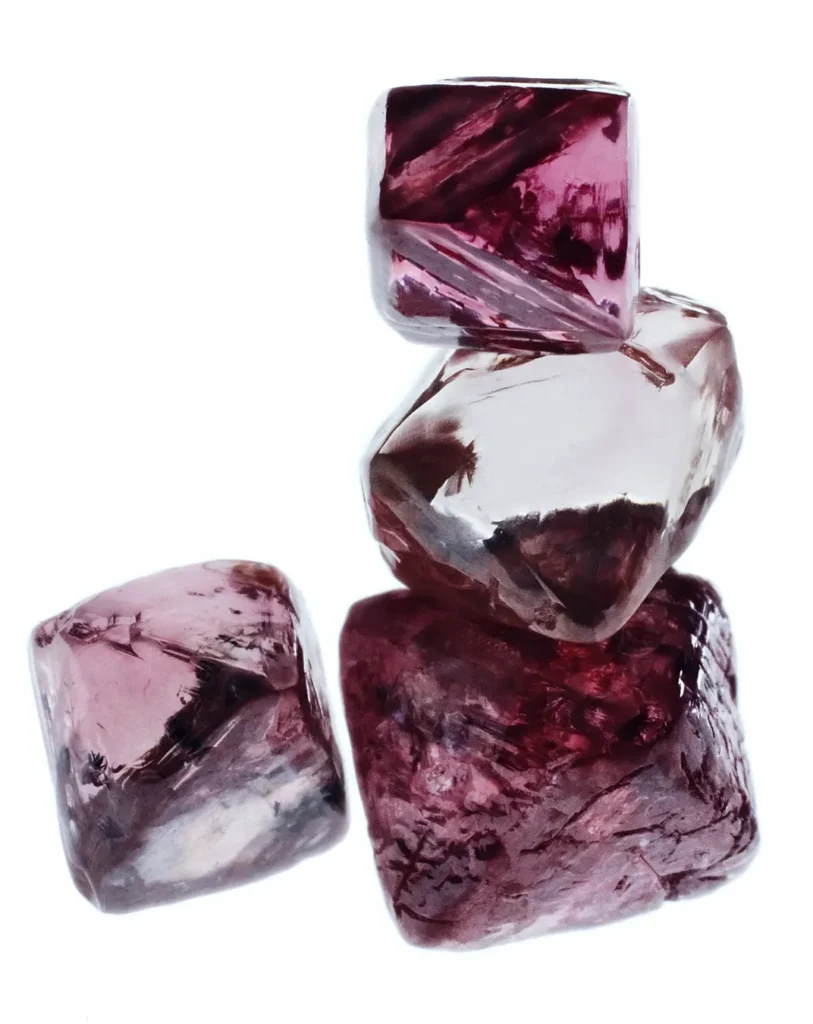The Origins of Australia’s Pink Diamonds: Did you know that Australia is a treasure trove for rare pink diamonds? Geologists have recently made significant breakthroughs in understanding the origins of these dazzling, blush-colored gems. Located near the edge of the continent, the Argyle mine in Western Australia has been responsible for over 90 percent of all natural pink diamonds discovered to date. Through meticulous analysis of rocks and minerals, scientists have unearthed fascinating insights into the formation of these rare diamonds. It turns out that the diamonds were created around 1.3 billion years ago, when a supercontinent named Nuna broke up, causing the gems’ crystal structure to contort and turn pink. With this newfound knowledge, researchers now believe that there might be other pink diamond troves waiting to be discovered around the world. So, the next time you marvel at the beauty of a pink diamond, you’ll have an even deeper appreciation for its ancient origin story.
Overview of Pink Diamonds
Pink diamonds are a rare and highly coveted gemstone known for their stunning beauty and unique color. In this comprehensive article, we will delve into the visual and structural characteristics of pink diamonds, their global distribution and frequency of occurrence, and why they are considered a geological anomaly.
Visual and Structural Characteristics of Pink Diamonds
Pink diamonds stand out from other diamonds due to their rare and distinct color. They range in color from a delicate shade of pink to a deeper reddish hue, and their color intensity can vary greatly. Pink diamonds are appreciated for their exquisite beauty and are often regarded as some of the most desirable gemstones in the world.
In terms of their structural characteristics, pink diamonds possess a crystalline structure that sets them apart from other diamonds. Under intense pressure, the crystalline structure of diamonds gets bent, leading to the pink coloration. The color transformation from colorless to pink to brown is a result of this structural change.

Global Distribution and Frequency of Occurrence
Pink diamonds are incredibly rare, accounting for only a small fraction of the world’s diamond production. What makes them even more unique is their limited geographic distribution. While most diamonds are found in the middle of continents, pink diamonds have a different pattern of occurrence.
The Argyle mine in Western Australia has played a significant role in the global distribution of pink diamonds. It is responsible for more than 90 percent of all natural pink diamonds ever discovered. This concentration of pink diamonds in one location makes them even more precious and desirable.
Why Pink Diamonds are a Geological Anomaly
Pink diamonds are considered a geological anomaly due to several factors. Firstly, their occurrence near the edge of the continent is highly unusual for diamonds. Most diamonds are formed in the middle of continents, making the presence of pink diamonds in Western Australia’s Argyle mine a fascinating geological phenomenon.
Additionally, pink diamonds at the Argyle mine are encased in a volcanic rock called lamproite, whereas most diamonds are found in kimberlite. This uniqueness further adds to the geological anomaly surrounding pink diamonds.

Formation Process of Pink Diamonds
To understand the formation of pink diamonds, it is essential to comprehend the general process of diamond formation. Diamonds are formed in the Earth’s upper mantle under intense heat and pressure. They usually start out as colorless crystals.
However, specific crystalline structural changes occur under extreme pressure, leading to the vibrant pink color of pink diamonds. This process involves the bending of the diamond’s crystalline structure, resulting in the unique coloration.
The transformation from colorless to pink to brown occurs as the pressure increases even further. The intensity and hue of the pink color can vary depending on the depth and duration of the diamond’s exposure to pressure.
Argyle Mine in Western Australia
The Argyle mine, located in Western Australia, holds great significance in the world of pink diamonds. It has been one of the largest sources of natural diamonds globally and has contributed significantly to the distribution of pink diamonds.
The Argyle mine operated from 1983 to 2020, during which it produced more than 90 percent of all natural pink diamonds discovered so far. This mine’s closure was due to the increased difficulty in extracting the remaining pink diamonds, further enhancing their rarity and value.

The Origins of Australia’s Pink Diamonds
Mining History and Closure of the Argyle Mine
The Argyle mine has a rich mining history that spans several decades. It was a key player in the diamond industry, particularly renowned for its production of pink diamonds. The mine operated for nearly 40 years, providing the world with an abundant supply of these rare gemstones.
However, as the mining operations progressed, the remaining pink diamonds became increasingly challenging to access. This led to the eventual closure of the Argyle mine in 2020, marking the end of an era for pink diamond production.
Proportional Contribution of Argyle Mine to Global Pink Diamond Distribution
The Argyle mine’s closure has had a significant impact on the global distribution of pink diamonds. As the primary source of natural pink diamonds, the mine had contributed an overwhelming proportion to their distribution.
With more than 90 percent of all natural pink diamonds discovered originating from the Argyle mine, its closure has further limited the availability of these precious gemstones. The scarcity and rarity of pink diamonds from this mine only serve to increase their value and desirability.

Unique Peculiarities of Argyle Mine
The Argyle mine is known for its unique peculiarities that make it stand out from other diamond mines. One notable characteristic is its location near the edge of the continent. Typically, diamonds are found in the middle of continents, making the presence of pink diamonds at the Argyle mine highly unusual.
Another remarkable aspect of the Argyle mine is the encasement of diamonds in lamproite, a volcanic rock. Most diamonds are found in kimberlite, making the lamproite-encased diamonds at the Argyle mine even more exceptional.
The deviation of the Argyle mine from typical diamond locations nestled within continents adds to the geological curiosity surrounding pink diamonds.
Geological Origin of Argyle Pink Diamonds
The geological origin of Argyle pink diamonds can be traced back to the formation of the supercontinent Nuna and subsequent geological events. Around 1.8 billion years ago, two sections of continental crust collided, leading to the formation of the supercontinent.
The site where the continental collision occurred is the same location where the Argyle diamond deposit is situated today. This collision event contorted the crystal structure of the diamonds, resulting in their distinctive pink color.
Approximately 500 million years later, Nuna broke up. Although the breakup did not occur precisely at the Argyle location, the forces associated with it caused stretching in the area. This stretching weakened the region, allowing deep magma to erupt and bring pink diamonds closer to the surface.

Understanding the Argyle Site Contributions
The collision of continental crust and the subsequent formation of Nuna had a significant impact on the Argyle site and the emergence of pink diamonds. This collision created a land scar or a damaged area in the Kimberley region that remains to this day.
The collision altered the crystal structure of the diamonds, giving rise to their pink coloration. The scar created by the collision is crucial in understanding the geological processes involved in the formation of pink diamonds.
Furthermore, the stretching that occurred during the breakup of Nuna played a role in bringing pink diamonds to the surface. Continental stretching subsequent to the collision weakened the region, allowing deep magma to reach closer to the diamonds and facilitate their ascent.
What the Argyle Mine Operations Reveal
The operations of the Argyle mine provide valuable insights into the possibilities of undiscovered pink diamond troves elsewhere. The concentration of pink diamonds in one location highlights the likelihood of similar deposits existing in other parts of the world.
However, the extraction of remaining pink diamonds presents significant challenges due to the location of these potential troves. If other pink diamond deposits formed near the edges of continents, they might be buried under sediment and rock, making their extraction difficult.
The experiences and lessons learned from the Argyle mine operations can guide future exploration and mining efforts in the search for new sources of pink diamonds.
Dating the Emergence of Pink Diamonds
Determining the timeline of pink diamond emergence is crucial in understanding their geological significance. To date the emergence of pink diamonds, scientists have utilized radioactive decay measurement in minerals from the Argyle mine.
The findings from these measurements have led to adjustments in the previously established timeline of pink diamond formation. The new timeline pushes back the estimate for when the pink diamonds first emerged, dating the Argyle deposit to 100 million years earlier than previously thought.
This revised timeline aligns more closely with the breakup of the supercontinent Nuna, lending support to the hypothesis that geological events linked to Nuna’s breakup played a role in the formation of pink diamonds.
Remaining Geological Questions on Pink Diamonds
While significant progress has been made in understanding the geological origins of pink diamonds, some questions still remain unanswered. One puzzling aspect is the high carbon content found in the Argyle formation.
Diamonds are primarily composed of carbon, but the exact reasons behind the abundance of carbon in the Argyle formation are not yet fully understood. Further research is needed to uncover the mechanisms that led to the high carbon content and its significance in pink diamond formation.
These remaining geological questions indicate that there is still more to learn about the fascinating story of Argyle pink diamonds.
Moving Forward in Pink Diamond Exploration
The discoveries and knowledge gained from studying the Argyle mine open up possibilities for future pink diamond exploration. The unique characteristics and formation processes associated with pink diamonds provide insights into potential areas for new findings.
Considering the likelihood of undiscovered pink diamond troves elsewhere, exploration efforts can be directed towards areas that meet specific criteria. Deep carbon, continental collision, and subsequent stretching are key ingredients that scientists believe are necessary for the formation of pink diamonds.
Advances in technology and scientific methodologies will enhance our ability to identify and extract pink diamonds from these potential areas. The study of Argyle pink diamonds offers valuable implications for future gemstone exploration and the understanding of Earth’s geological processes.
In conclusion, pink diamonds are not only breathtakingly beautiful gemstones but also geological anomalies. Their unique color, occurrence near the edge of continents, and encasement in volcanic rock make them truly extraordinary. The story of Argyle pink diamonds, with its geological origins and the closure of the mine, reveals the continued mysteries and awe-inspiring nature of these rare gemstones. As we move forward in exploration and discovery, the study of pink diamonds will undoubtedly continue to captivate scientists and gemstone enthusiasts alike.
